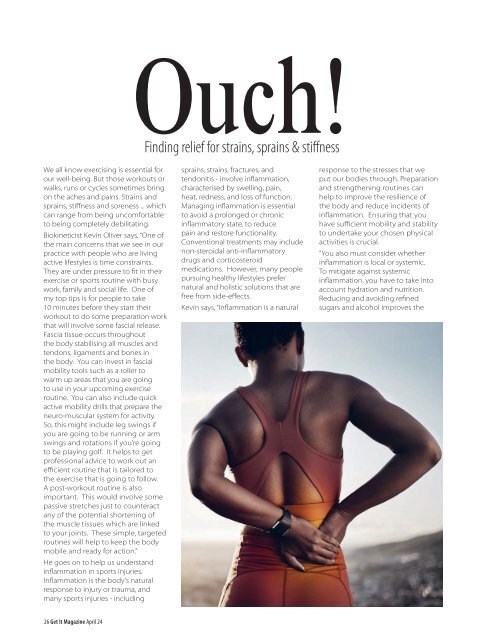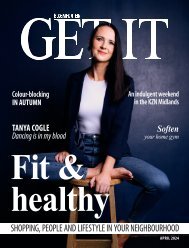JHB North - April 24
Happy & healthy
Happy & healthy
Create successful ePaper yourself
Turn your PDF publications into a flip-book with our unique Google optimized e-Paper software.
Ouch!<br />
Finding relief for strains, sprains & stiffness<br />
We all know exercising is essential for<br />
our well-being. But those workouts or<br />
walks, runs or cycles sometimes bring<br />
on the aches and pains. Strains and<br />
sprains, stiffness and soreness ... which<br />
can range from being uncomfortable<br />
to being completely debilitating.<br />
Biokineticist Kevin Oliver says, “One of<br />
the main concerns that we see in our<br />
practice with people who are living<br />
active lifestyles is time constraints.<br />
They are under pressure to fit in their<br />
exercise or sports routine with busy<br />
work, family and social life. One of<br />
my top tips is for people to take<br />
10 minutes before they start their<br />
workout to do some preparation work<br />
that will involve some fascial release.<br />
Fascia tissue occurs throughout<br />
the body stabilising all muscles and<br />
tendons, ligaments and bones in<br />
the body. You can invest in fascial<br />
mobility tools such as a roller to<br />
warm up areas that you are going<br />
to use in your upcoming exercise<br />
routine. You can also include quick<br />
active mobility drills that prepare the<br />
neuro-muscular system for activity.<br />
So, this might include leg swings if<br />
you are going to be running or arm<br />
swings and rotations if you’re going<br />
to be playing golf. It helps to get<br />
professional advice to work out an<br />
efficient routine that is tailored to<br />
the exercise that is going to follow.<br />
A post-workout routine is also<br />
important. This would involve some<br />
passive stretches just to counteract<br />
any of the potential shortening of<br />
the muscle tissues which are linked<br />
to your joints. These simple, targeted<br />
routines will help to keep the body<br />
mobile and ready for action.”<br />
He goes on to help us understand<br />
inflammation in sports injuries.<br />
Inflammation is the body's natural<br />
response to injury or trauma, and<br />
many sports injuries - including<br />
sprains, strains, fractures, and<br />
tendonitis - involve inflammation,<br />
characterised by swelling, pain,<br />
heat, redness, and loss of function.<br />
Managing inflammation is essential<br />
to avoid a prolonged or chronic<br />
inflammatory state, to reduce<br />
pain and restore functionality.<br />
Conventional treatments may include<br />
non-steroidal anti-inflammatory<br />
drugs and corticosteroid<br />
medications. However, many people<br />
pursuing healthy lifestyles prefer<br />
natural and holistic solutions that are<br />
free from side-effects.<br />
Kevin says, “Inflammation is a natural<br />
response to the stresses that we<br />
put our bodies through. Preparation<br />
and strengthening routines can<br />
help to improve the resilience of<br />
the body and reduce incidents of<br />
inflammation. Ensuring that you<br />
have sufficient mobility and stability<br />
to undertake your chosen physical<br />
activities is crucial.<br />
“You also must consider whether<br />
inflammation is local or systemic.<br />
To mitigate against systemic<br />
inflammation, you have to take into<br />
account hydration and nutrition.<br />
Reducing and avoiding refined<br />
sugars and alcohol improves the<br />
26 Get It Magazine <strong>April</strong> <strong>24</strong>

















